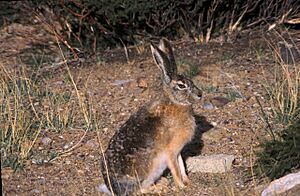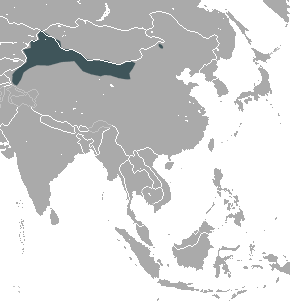Desert hare facts for kids
Quick facts for kids Desert hare |
|
|---|---|
 |
|
| Conservation status | |
| Scientific classification | |
| Genus: |
Lepus
|
| Species: |
tibetanus
|
 |
|
| Desert hare range | |
The desert hare (Lepus tibetanus) is a type of hare that lives in Central Asia, Northwest China, and parts of India. These hares prefer to live in grassland and scrub areas found in desert and semi-desert regions. Not a lot is known about them. The International Union for Conservation of Nature (IUCN) says the desert hare is a "least concern" animal. This means it is not currently in danger of disappearing.
Contents
What Does the Desert Hare Look Like?
The desert hare is a light and slender animal with a small head. Its body can be about 40 to 48 centimeters (16 to 19 inches) long. Its tail is shorter, measuring about 9 to 11 centimeters (3.5 to 4.3 inches).
The fur on its back is sandy-yellow to dull brown, often with black tips. Its hips are greyish, and its belly is yellowish-white. Around its eyes, the skin is pale. The hare has wide ears with fluffy hair inside, and the tips of its ears are black. Its front paws are white, and so are the outer parts of its back legs. The top of its tail has a brownish-black stripe. In winter, the hare's fur gets thicker and turns a sandy-grey color.
Where Do Desert Hares Live?
Desert hares are native to Central Asia. You can find them from Afghanistan and northern Pakistan all the way to Mongolia and parts of northern China, like Xinjiang, Gansu, and Inner Mongolia.
These hares live in dry and semi-dry places. They can be found in scrubby deserts, grasslands, and steppes. They live at high altitudes, sometimes as high as 3,500 to 4,000 meters (11,500 to 13,000 feet) above sea level.
How Do Desert Hares Live?
Desert hares are plant-eaters, which means they are herbivores. Their diet includes roots, leaves, stems, berries, and seeds. Sometimes, they even eat cactus plants to get moisture.
They usually look for food around sunset. However, you might sometimes see them out during the day. Unlike some other animals, hares do not dig burrows to live in. Instead, they hide in shallow dips in the ground. Female desert hares can have up to three groups of babies each year. Each time, they typically have between three and ten young hares.
Is the Desert Hare in Danger?
The desert hare lives across a very wide area. However, scientists do not know exactly how many desert hares there are or if their numbers are changing.
The International Union for Conservation of Nature (IUCN) has listed the desert hare as a species of "least concern." This means they believe the hare is not currently facing major threats. Even if its population is shrinking, it is likely doing so very slowly, not fast enough to be considered endangered.


